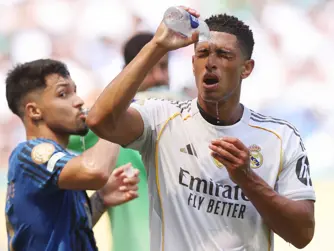News
Eleven tips for dealing with hot conditions in professional football

- Report released with guidelines and mitigation strategies for hot conditions in professional football
- Series of studies show national team players unanimously agreed that hot and humid conditions made performance difficult during matches
- Eleven 'Hot Tips' that should be considered by governing bodies, competition organisers, and more to better protect players’ health
FIFPRO has released a report with guidelines and mitigation strategies for hot conditions in professional football.
Following several high-profile international competitions played in hot conditions, a series of cross-sectional studies showed that national team players and managers unanimously agreed that hot and humid conditions made performance difficult during these matches.
The report contains 11 ‘Hot Tips’ that should be considered by governing bodies, competition organisers, clubs, staff members and players to better protect players’ health.
Guidelines and Mitigation Strategies for Hot Conditions in Professional Football

“The human body maintains a constant core temperature that usually ranges from 36.1°C to 37.8°C – and in extreme heat, players are at risk of suffering from heat-stress disorders such as heat cramps, heat exhaustion or heat strokes,” said FIFPRO’s Chief Medical Officer Prof Dr Vincent Gouttebarge.
“To prevent or mitigate this risk and thus to protect players’ performance and health, better guidelines relying on the Wet Bulb Globe Temperature (WBGT), or on the ambient temperature, should be implemented and enforced.”
FIFPRO’s position on extreme heat
At present, FIFA guidelines state that if there is a WGBT of more than 32°C (89.6°F) cooling breaks are mandatory in both halves of a match, around the 30th minute and 75th minute. The decision on whether to suspend or cancel the match is at the discretion of competition organisers.
FIFPRO believes that these guidelines do not do enough to protect the health and performance of players and recommend among other things that if there is a WBGT between 28-32°C, cooling breaks should take place around the 30th minute and 75th minute. If there is a WBGT of more than 32°C, training and matches should be rescheduled.

FIFPRO’s 11 Hot Tips
- Heat guidelines should be adopted and respected by football stakeholders, clubs and national teams for matches and training and embedded within regulations (e.g., minimum medical requirements, laws of the games, collective bargaining agreement for national competitions; FIFA competition regulations, social dialogue).
- Heat guidelines should refer to thresholds for WBGT (especially in elite professional football) and ambient (in case a WBGT measurement device is unavailable) temperature to increase their understanding and global implementation across all levels of professional football.
- A WBGT above 26°C (or ambient temperature above 30°C) should warrant cooling breaks during matches (e.g., at approximately 30 minutes in each half of a match).
- A WBGT above 28°C (or ambient temperature above 36°C) should lead to the delay or postponement of matches until conditions for players and officials (and fans) are safer.
- WBGT (and/or ambient temperature) should be measured on-site before each match and training session (e.g., two hours), and consultation between key stakeholders (e.g., players, coaches, match officials, team physicians) about potential risks should occur.
- National and local weather forecasts should monitor the weather conditions (e.g., at least five days before each match) and estimate potential hot conditions to schedule matches (and training) optimally and provide players with a safe environment.
- Next to additional cooling breaks, other mitigation strategies (e.g., heat acclimation/acclimatisation, cooling methods, easy availability of cool drinks all around the football field) should be planned and used for matches and training, with responsibility for their implementation resting with teams and individuals involved.
- Stakeholders (international, continental, national) and television broadcasting companies should not schedule matches at the hottest time of day, that means avoiding mid-day or afternoon matches (i.e., full sunshine) where high WBGT is most likely.
- A (inter)national registry of heat-related collapses and/or deaths should be developed to assess their prevalence, explore the underlying contributing factors, and improve existing guidelines and mitigation strategies.
- While players’ responses (e.g., physiological, cognitive) when exercising in hot conditions have been extensively studied, more research is needed to understand (i) how thresholds (WBGT and/or ambient temperature) in heat guidelines could evolve, (ii) how mitigation strategies, including potential modification of the laws of the game and heat acclimation/acclimatisation, could be optimally implemented and enforced in practice, and (iii) how new technologies might enable the assessment of personal factors (e.g., metabolic rate, thermoregulatory function) and contribute to the prediction of the risk of heat-related illnesses.
- Particular attention should be given to female and youth players with regard to individual responses when exercising in hot conditions or when it comes to avoiding television broadcasts of their matches at mid-day or in the afternoon (i.e., full sunshine).
